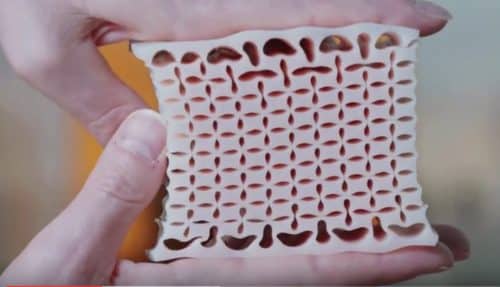Scientists at Tel Aviv University, in collaboration with Dutch researchers, engineered a new metamaterial with unique properties and great application potential * In the future, the material could be used to build customized prostheses for amputees. Additional uses are expected in soft robots, as well as in future installations of wearable technologies, which must be attached to the body with great precision in order to operate optimally

An innovative metamaterial, developed by scientists at Tel Aviv University and the Netherlands, enables a perfect match between the surface of the material and uneven surfaces, with bumps and depressions. Due to its unique properties, it can be particularly suitable for applications that adhere to the human body, such as customized and comfortable prostheses, and a variety of wearable technologies. The study was published in the scientific journal Nature on July 27, 2016.
"Metamaterials are smart materials that have been engineered by humans, and are not found in nature," explains Dr. Yair Shokoff, head of the research group at the School of Mechanical Engineering at Tel Aviv University. "Unlike 'normal' materials, whose properties are determined by their chemical composition (atoms and molecules), the physical properties of metamaterials derive from their spatial structure. In other words: the special building blocks, and the way they fit together, determine the properties of the metamaterial. In the new study, we developed a ground-breaking, three-dimensional, non-cyclic metamaterial with great application potential."
The researchers chose to focus on the mechanical properties of metamaterials, and in particular flexibility. Dr. Shokoff says: "All the metamaterials developed to date have been homogeneous and have a cyclical structure - that is, one template that repeats itself over and over again. Our colleagues in the Netherlands succeeded in developing hollow cube-like building blocks, which allow flexibility. We then used computational tools to build larger XNUMXD structures from these cubes, programmed 'to order'. Smart placement of the building blocks inside the building allows us to create any requested pattern of bumps and depressions on the outer surface of the buildings."
Thanks to the lack of periodicity, the new metamaterial is especially suitable for interfaces with biological surfaces, which are in motion and are not uniform by nature - especially in the human body. For example, in the future it will be possible to build prostheses from it that fit very precisely on the stump, and improve the sensation and function of amputees. Additional uses are expected in soft robots, as well as in future installations of wearable technologies, which must be attached to the body with great precision in order to operate optimally.
An explanatory video of the journal NATURE:
Another video:
for the scientific article
Corentin Coulais, Eial Teomy, Koen de Reus, Yair Shokef and Martin van Hecke
Combinatorial Design of Textured Mechanical Metamaterials
Nature 535, 529-532 (2016)
